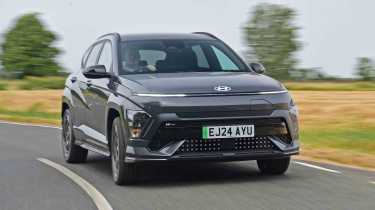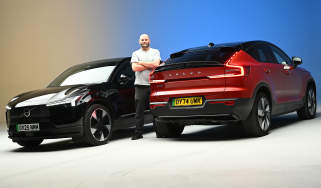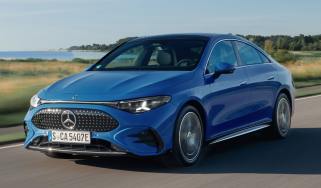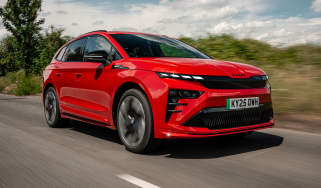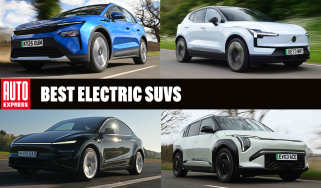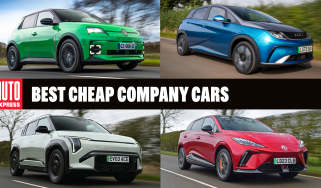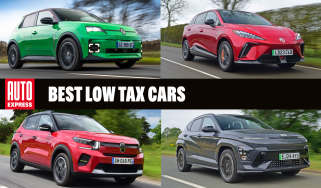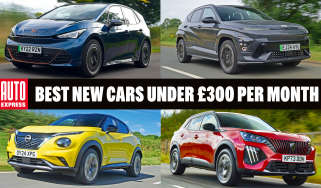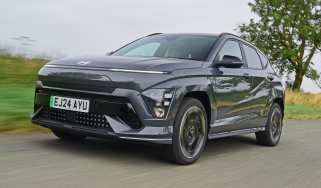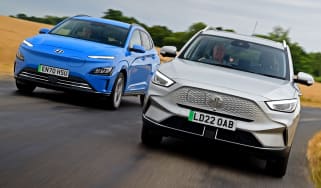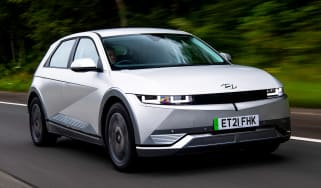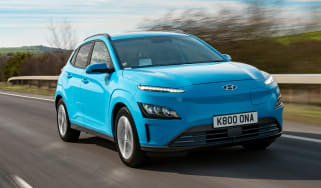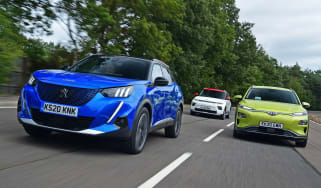Hyundai Kona Electric review
The Hyundai Kona Electric is one of the best small SUVs around and a previous Car of the Year winner

Our opinion on the Hyundai Kona Electric
The original Hyundai Kona Electric was good, but the second-generation model is even better. It’s larger, which means it’s more practical than many of its rivals, while a combination of plush materials and the latest tech make the interior feel more upmarket than before. The entry-level version with the smaller battery is temptingly affordable, while the larger battery offers up to 319 miles of range from a full charge. Small wonder we deemed it good enough to win the coveted Auto Express Car of the Year 2023 trophy.
| Key specs | |
| Fuel type | Electric |
| Body style | Five-door SUV |
| Powertrain | 65.4kWh battery, 1x e-motor front-wheel drive |
| Safety | Four-star Euro NCAP (2023) |
| Warranty | 5yrs/unlimited mileage |
About the Hyundai Kona Electric
The entry-level Hyundai Kona Electric costs a reasonable £35,000 for a car in Advance trim and with the 65.4kWh battery. Mid-range N Line adds £2,000 to that, coming in at £37,000. Both the feature rich N Line S and Ultimate trims cost around £39,500.
The Kona Electric comes with a generous level of equipment as standard, but there are a handful of optional extras available. These include metallic paint (£650), a two-tone roof on the N Line and N Line S models (£500) and full leather upholstery on the Ultimate trim (£900).
Lux packs are available on the N Line S and Ultimate trims and, depending on the model, include memory settings for the driver’s seat, digital key, remote park assist and a heated charging door. You will need to be careful with these because adding them will push the price of the Kona Electric above the £40,000 luxury car tax threshold, adding considerably to the yearly VED cost between the second time the vehicle is taxed until it is six years old.
Used - available now
If you're interested in purchasing a Hyundai Kona Electric, we can assist you. Configure your ideal Hyundai Kona Electric now to get top offers from local dealers, check out the latest Hyundai Kona Electric leasing deals or search for used Hyundai Kona Electric models with our Find A Car service. You can even sell your existing car for a great price with Auto Express Sell My Car.
Electric motor, performance & drive
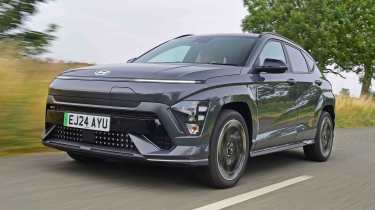
Pros |
Cons |
|
|
The latest Kona is bigger than before in every dimension than its predecessor, but its turning circle hasn’t increased, remaining at 10.6 metres. The steering is light, and you can easily turn the wheel with one finger – although we obviously wouldn’t recommend this on the road. That might be good for parking, but there’s virtually no feedback at higher speeds, meaning the Kona Electric isn’t a particularly exciting car to drive on a twisty B road.
We found the Kona Electric wasn’t quite as eager at motorway speeds, but should you need to overtake a tractor on a B road, there’s enough punch to do so reasonably quickly. Even when you’re thrashing the Kona, its refinement remains excellent. There’s plenty of suspension travel to deal with cratered roads, but the suppleness doesn’t result in too much body lean in the corners. It’s a good balance with a clear focus on comfort.
The Advance comes on 17-inch wheels rather than the 19-inch rims found on the rest of the range, and we suspect these go some way to enhancing that impressive ride quality. If you go for high-end Ultimate trim and you value a comfortable ride, you can select the smaller 17-inch wheel option as a no-cost option, which also means you maintain a higher driving range between charges and better efficiency due to the lower rolling resistance of smaller wheels.
Like many Kia and Hyundai EVs, the Kona Electric features a four-level regenerative braking system, along with a one-pedal drive mode. This allows drivers to tailor the rate of deceleration after lifting off the accelerator, thereby boosting their overall driving efficiency by generating electricity that can be stored in the battery. Variable regenerative braking adds another level of engagement to the driving experience over, say, a Volvo EX30, which only has a single mode (on or off) with no chance to vary the braking to suit the road you’re on or the traffic conditions around you.
One word or warning, though. If you switch the system off in the Kona and use the brake pedal instead, you need to give it a bit of a shove before the car starts to slow down.

Performance, 0-60mph acceleration and top speed
The smaller battery model and its 154bhp electric motor have been removed from the order books, so all Kona Electric models presently come with 215bhp and the larger 65.4kWh battery pack. This means that all Konas will manage the 0-62mph dash in 7.8 seconds, and go on to a top speed of 107mph, which are very healthy figures for an SUV.
In typical electric car fashion, the torque delivery is instant, and around town, the Kona has the grunt to feel very nippy. So grunty, in fact, that it’s easy to cause the front wheels to scramble for grip with too much throttle thanks to 255Nm of torque.
“Rather than my usual practice of getting to the nearest ‘fast’ road, we took a direct route on back roads. We got stuck behind some farm traffic, but I could safely and surprisingly quickly overtake it with the Kona Electric, much to the enjoyment of my passengers.” – Darren Wilson, Creative director
| Model | Power | 0-62mph | Top speed |
| Kona Electric Advance 65.4kWh | 215bhp | 7.8 seconds | 107 mph |
Range, charging & running costs
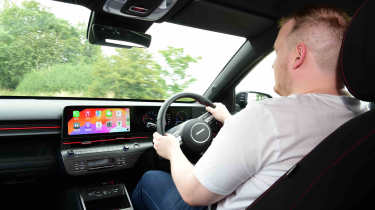
Pros |
Cons |
|
|
Electric range, battery life and charge time
With the removal of the 48.4kWh version, the sole battery capacity currently available in a Kona Electric is the 65.4kWh version with up to 319 miles of driving range. If you opt for the N-Line, N-Line S, or Ultimate trim levels, the standard 19-inch wheels on these versions will reduce the range to just 282 miles. However, on the Ultimate trim, you can specify the smaller 17-inch wheels used in the Premium trim, and this restores the range to 319 miles – something that might be worthwhile for those regularly travelling long distances.
Unlike many of its rivals, though, the Kona will get close to that figure all year round thanks to a standard-fit heat pump, which is a more efficient way of heating the interior of a car in colder weather.
The peak charging figure is 101kW charging speed, allowing for a 10 to 80 per cent top-up time to 34 minutes. That’s on par with most of its rivals, but it’s by no means the fastest around, and is still beaten by alternatives like the Skoda Elroq or Volvo EX30, both of which have higher peak charging speeds and can handle a similar 10 to 80 per cent top up in around 25 minutes. For those charging up at home using a typical 7kW wallbox charger, refilling a flat Kona Electric to full will take around 10.5 hours.
EVs are no longer exempt from vehicle excise duty (VED) road tax, but you can get into the London ULEZ area for free until December 2025. You’ll be subject to the standard rate of VED provided you don’t go above the £40,000 luxury car tax threshold, which is entirely possible if you go for the high-end N-Line S or Ultimate trims and specify the Lux Pack. Those premium relaxation seats might not seem quite so comfortable when you consider that you’ll be paying a hefty additional surcharge every year between the second time the vehicle is taxed up until it is six years old.
However, it’s company car drivers who will see the biggest savings due to extremely low Benefit-in-Kind (BiK) taxation for electric vehicles when compared with regular petrol and diesel cars.
The Kona Electric might not be the cheapest EV of its kind to insure, though. With the loss of the less powerful version, this Hyundai now starts in group 31 instead of group 25 as before. That puts the Kona Electric on par with the Kia EV3, but for those looking for cheaper insurance, they should consider a Skoda Elroq, which starts in group 22.
The Kona electric should hang on to 45 per cent of its original purchase price after three years and 36,000 miles, according to our expert data. That’s a little behind the EV3 (45 to 49 per cent) and Elroq (48 to 52 per cent), but it’s considerably better than the Peugeot E-2008, which is only expected to retain 36 per cent of its value over the same period.
| Model | Battery size | Range | Insurance group |
| Kona Electric Advance 65.4kWh | 65.4kWh | 319 miles | 31D |
| Kona Electric Ultimate 65.4kWh (wi 19-inch wheels) | 65.4kWh | 282 miles | 33D |
Design, interior & technology
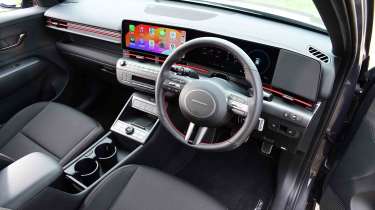
Pros |
Cons |
|
|
Don’t think the base-spec Kona Electric lacks equipment because there’s dual-zone climate control, front and rear parking sensors with a rear-view camera, Android Auto and Apple CarPlay connectivity, two USB-C ports up front and two in the rear. There are even the same twin 12.3-inch screens found in the higher specification Kona models.
There’s some clear influence from the brand’s Ioniq range of cars with the Kona, not just with the pixelated lightbars and eye-catching angular design on the outside, with a tasteful interior, too. It’s a pleasant place to sit with plenty of room front and rear, and it certainly feels well screwed together, although it would be nice to be able to choose from a different interior colour other than the standard shade of grey. The N-Line trim and above feature some ambient interior lighting to enhance the ambience and a couple of sportier touches to differentiate it better from the more conservative Advance and Ultimate trims.
Hyundai proudly states that the Kona’s interior is a result of customer feedback, which is usually reassuring. Yes, there are larger screens on the dash, which is customary for most EVs with premium aspirations, but we like the fact they’ve kept physical buttons for frequently used functions like the radio and climate controls, making it easier to make quick adjustments while driving than in rivals that only use touchscreen-based controls.
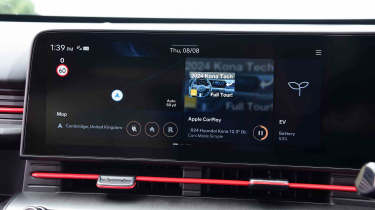
Infotainment, sat-nav and stereo
The infotainment system is a doddle to use in the Kona, and even the Advance version comes with sat-nav and EV route planning to help make sure you’re not scrambling to find a charger. Hyundai says over-the-air updates will be made available throughout the Kona’s lifespan, potentially including an ‘app shop’ to add more widgets and functionality to the menu.
There are a lot of menus to navigate through, though, and while you can save a shortcut to your most commonly used one on the star favourites button on the steering wheel, we’d advise you to use that for quick access to turn off the speed limit warning system, because that is very eager to tell you off and is a pain to silence once on the move.
Music lovers will likely want an N-Line S or higher trim level to get the better-sounding Bose sound system. Wireless smartphone charging is available as part of the Comfort pack on entry-level Advance trim, or as standard on N-Line trim and above.
“The N Line’s sports seats are not deep racing buckets, but have just enough side bolstering to feel supportive yet still comfortable on longer journeys. The black, grey and red colour scheme does make the interior feel a little gloomy.” – Ellis Hyde, News reporter
Boot space, comfort & practicality
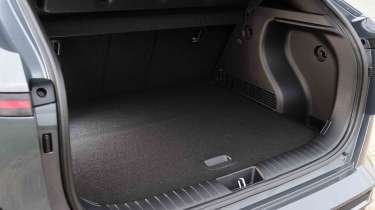
Pros |
Cons |
|
|
The larger exterior dimensions of the latest Hyundai Kona Electric over its predecessor mean that there’s more headroom, legroom and shoulder room than before. In fact, we found the amount of space inside is not dissimilar to that of its larger Hyundai Tucson sibling, and even our creative director Darren Wilson found there to be plenty of room in the rear for three adults or two large child seats when he ran one as part of a long term test. Up front, the driving position is higher up than it was before, giving the car a greater feeling of presence.
We also found it much less of a struggle to fit a child seat into the back of the Kona than in a Honda e:Ny1 because the ISOFIX mounts in the Hyundai poke out from the seat bases, and are easier to locate. In the Honda, they’re buried deep and are very hard to reach.
All versions of the Kona Electric come with Vehicle to Load (V2L) charging capability, which means you can power anything from a kettle to a microwave using the three-pin socket in the centre console.
Dimensions and size
As we’ve already mentioned, the Kona Electric has grown in size, being 150mm longer, 12mm taller, and 25mm wider. In total, that makes the latest Kona 4,322mm long, 1,580mm tall, and 1,825mm wide.
That’s both longer and taller than the Volvo EX30 (although the EX30 is wider), but not quite as big as the Skoda Elroq.
| Dimensions | |
| Length | 4,355mm |
| Width | 1,825mm (2,100mm inc mirrors) |
| Height | 1,580mm |
| Number of seats | Five |
| Boot space | 466-1,300 litres |
Boot space
The boot provides a handy 466 litres of luggage capacity, up from 374 litres in the old car, and the space increases to 1,300 litres with the rear seats folded down. Both of those figures are significantly higher than what the Volvo EX30 offers, but while the Kona electric almost matches the seats-up figure for the Skoda Elroq, the latter outperforms the Hyundai when all the seats are lowered, providing up to 1,580 litres of IKEA flat-pack furniture-swallowing capacity.
There’s more space under the boot floor for storing the charging cables, and although the Kona Electric doesn’t have a proper ‘frunk’ under the bonnet, there’s enough space for a handbag or small shopping bag.
“As is the case with a lot of small EVs, the Kona Electric isn’t really cut out for hauling a trailer given its weedy 750kg braked towing capacity. You can get a tow bar fitted around £800, but it’s more for fitting a bike rack than attaching a caravan.” – Max Adams, online reviews editor
Safety & reliability
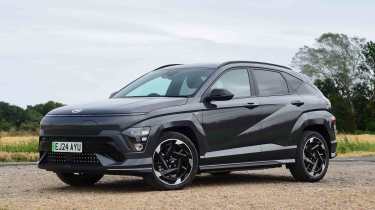
Pros |
Cons |
|
|
The standard version of the second-generation Hyundai Kona received a disappointing four-star safety rating when tested by Euro NCAP safety experts in 2023. A poor performance in the vulnerable road user protection test and the absence of driver assistance systems on low-spec models were behind the less-than-stellar rating for the Hyundai.
On the plus side, every Kona Electric is fitted with multiple airbags, a driver attention warning, forward collision avoidance assist, lane-keep assist, lane-follow assist, front and rear parking sensors, and a rearview camera.
We did find that some of the Kona’s driving assistance technology to be a bit intrusive when we tested a high-end Ultimate trim version of the Hyundai Kona Electric against the Honda e:Ny1. The lane keep assist was overly intrusive and was best switched off, while the driver attention alert system chimed in far too often.
The N Line S and Ultimate models are equipped with blind spot monitoring to warn you of vehicles alongside you when you change lanes, and a rear cross-traffic collision avoidance assist to alert you to potential hazards when you reverse into a road. There’s also a safe exit warning so you don’t open the door on an approaching cyclist, along with a parking distance warning system, and a surround view monitor to help make parking that little bit easier.
Hyundai finished a middling 17th out of 32 on the list of manufacturers in our recent 2024 Driver Power customer satisfaction survey, with the infotainment system given the biggest thumbs up. Owners were less satisfied with the cabin quality, ride and handling, and driving pleasure. The fact that Hyundai’s sibling brand Kia finished third suggests that there’s work to be done for Hyundai.
At least owners can rely on Hyundai’s excellent five-year unlimited mileage warranty. Although Kia offers cover for seven years, it’s worth noting that the mileage is capped at 100,000 miles.
| Key standard safety features | Euro NCAP safety ratings |
|
|
Buying and owning
Best buy: Hyundai Kona Advance (Comfort Pack) engine trim level
With the removal of the smaller battery version, the choice of which battery size and motor combination is limited to just a 65.4kWh capacity battery and a 215bhp electric motor. We suggest sticking with the entry-level Advance trim, as it comes with smaller alloy wheels that offer less rolling resistance and provide the best overall driving range. We recommend adding the Comfort Pack to this package, because it enhances an already well-specified model by incorporating heated front and rear seats, a heated steering wheel (a particularly nice feature in winter), wireless phone charging, and rear privacy glass.
Hyundai Kona Electric alternatives
The Kona Electric is one of five EVs currently offered by Hyundai (which is soon to be six with the arrival of the seven-seat Hyundai Ioniq 9). The Kona range also offers the choice of petrol and hybrid power, if you’re not quite ready to take the leap into EV ownership, and you can read more about those choices in our dedicated Hyundai Kona review.
Key rivals for the electric Kona include the Kia Niro EV, which uses the same K3 platform as the Kona Electric. There’s also the excellent Kia EV3 to consider, which uses a dedicated battery electric vehicle (BEV) version of that platform, but with significantly more battery capacity and even greater range.
Other electric small SUVs, such as the Peugeot E-2008, Vauxhall Mokka Electric and Volkswagen ID.3 and Cupra Born. But perhaps its most significant challenger comes in the form of the Skoda Elroq, which has already seen off competition from the EV3 to win its group test, thanks to its blend of practicality, efficiency, value for money, and exceptional comfort.
Deals on the Hyundai Kona Electric and alternatives
Hyundai Kona Electric pictures
Frequently Asked Questions
The Hyundai Kona Electric comes with a five-year unlimited mileage warranty, which is better than many of its rivals.








